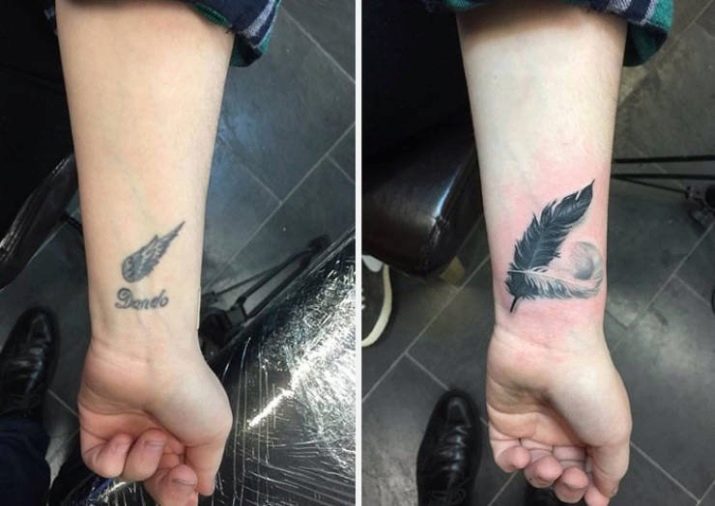All about tattoo overlap
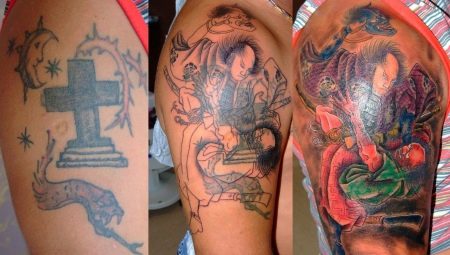
Overlapping an old tattoo is one of the ways to correct an unsuccessful drawing on the body. The best sketches and correction techniques, when chosen correctly, can produce impressive results. An overview of the most popular correction methods will help to understand how to interrupt tattoos on the arm and forearm, shoulder and wrist correctly.
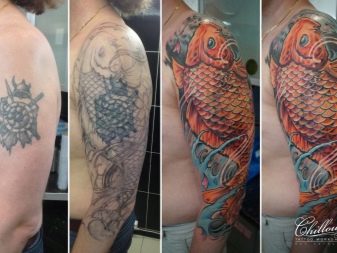
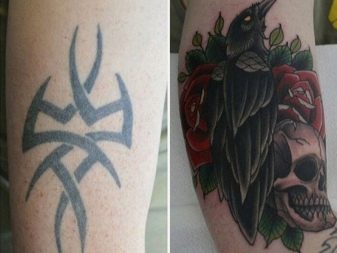
What is it and when is it needed?
Overlapping a tattoo is a fairly popular procedure performed in specialized salons. With the help of correction, you can hide the "sins of youth" or simply unsuccessful experiences with drawing a picture on the body. The decision to overlap tattoos can also be associated with the fading of the ornament over time, and sometimes old inscriptions or images simply lose their relevance. But much more often the desire to tattoo an already existing pattern is caused by its poor-quality performance.
Among the most fixable defects are:
- curved lines of the drawing;
- changed colors;
- stretching of the skin;
- deformation of the ornament after injury.

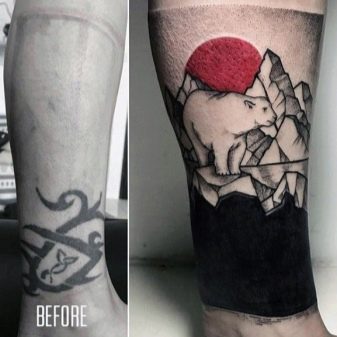
Quite often, people put inscriptions on their bodies with the names of their beloved and vows of eternal affection or symbols of a religious nature. But after parting, wearing such tattoos is not very comfortable. Changing ideals or religious beliefs is often just a matter of time. In addition, the contour tattooing, which has recently become fashionable, is quickly losing its relevance, but the lines remain noticeable. Here, too, you can go in different ways: get rid of traces of old paint or use overlapping to fix the poor work of the master.

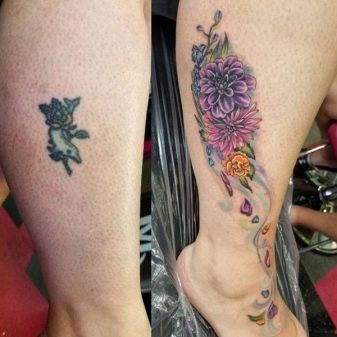
It is important to understand that the pigment already applied to the skin will not go anywhere during the correction.It remains in the fabrics when a new pattern is applied, and a new pattern or color always takes root unevenly.
Much depends on individual characteristics: skin elasticity, cell renewal rate, percentage of fat mass. Only after 4-5 weeks can you correctly evaluate the results from the changes made.

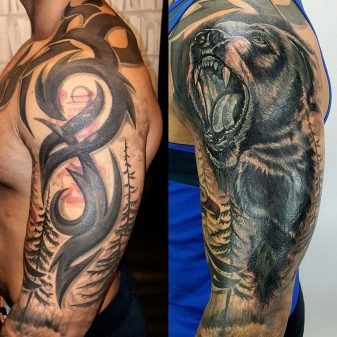
Not all tattoos can be covered. This must be taken into account before starting work. Experienced craftsmen immediately warn customers about this. Among the problems encountered more often than others, we can mention:
- areas of skin with scars;
- places that have already been corrected;
- areas with inflammation, wounds, traces of chronic rashes.
It is best to overlap with a replacement pigment tattoo in a linework or dotwork style. Weakly colored patterns with gaps or unfinished variations are also fairly easy to fix.
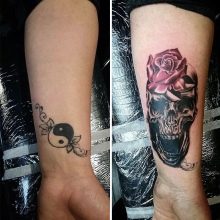
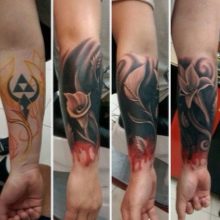
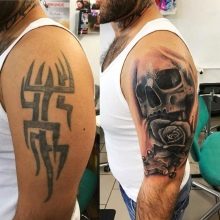
Selection of sketches and techniques
There are several styles of tattoo that are used for overlapping. The most popular is blackwork, which uses exclusively black or other dark pigments close to anthracite. Since the pigment floods most of the old tattoo, this is considered masculine. For girls, blackwork is also suitable, but it requires a lot of experience and the efforts of a master.
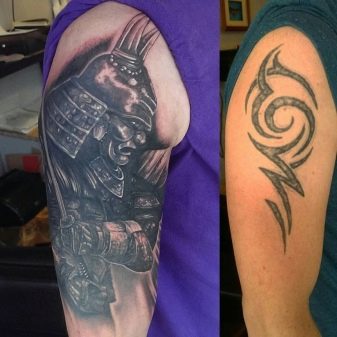

Small-sized tattoos, mostly for men, are often overlapped with Celtic patterns. In this case, knots and interlacing of lines with ornaments characteristic of this style are used. Women's tattoos are much more often overlapped with floral ornaments, bright colors, and sometimes they are simply supplemented with new details without unnecessary flashiness. Do not rely on light correction of graphic and abstract images. You cannot use light watercolors or portrait sketches here, you will have to look for a drawing that is similar in design.

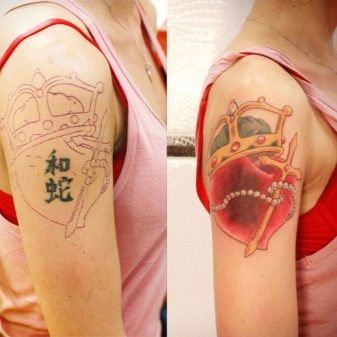
However, the choice of style largely depends on where the work will be corrected. A detailed review will help you understand the search for a sketch and technique for applying it.
On the arm, wrist and hand
Overlapping old tattoos on the arms is most often necessary. If we are talking about a sleeve that takes up a significant area of skin, it will be easiest to hide problem areas under a pattern using the blackwork technique. Writing on the bicep or wrist is quite easily disguised with tribal-style tattoos, in the form of wings or intricate interlacing of lines. Geometric ornaments will work too, and steampunk elements will fit well with the aesthetics of the lightly shaded original pattern.


On the shoulder, forearm and neck
These areas are some of the most popular tattoo areas. Often, over time, a drawing loses its clear contours, stretches and deforms. Girls often put the names of their beloved on their necks, and after parting, they cover them with an image with animalistic or floral motives. A butterfly, a flower, a favorite puppy - these are just a few of the ideas for correction.
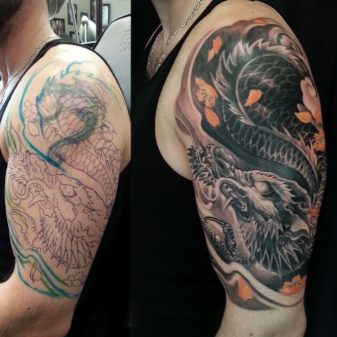

Large tattoos on the shoulder and forearm in men due to the peculiarities of the skin (large pores, hair follicles) most often have to be covered with a solid black tone. The larger the size of the pattern, the higher the likelihood that the master will recommend preliminary lightening of the old pattern. But don't be upset - an experienced tattoo artist will find a way to turn a "sleeve" or "bracelet" into a real masterpiece.


On the chest, back and ribs
The larger the tattoo, the more difficult it is to overlap. Most often, such stories are placed on the back. Very dark or large patterns often have to be partially discolored with a laser. This allows you to expand the selection of sketches, makes it easier to cope with the elimination of defects. On the scapula and ribs, the procedure is most painful. The old paint is usually hidden by color works with intricate sketches in ethnic, Mexican, or new school techniques.
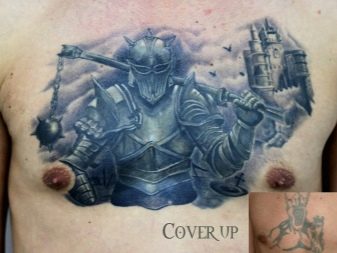
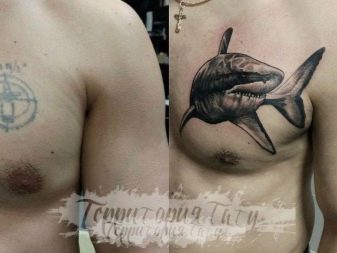
On the lower back and abdomen
The use of tattoos in these areas of the part is associated with the need to eliminate visible traces of stretch marks after gaining and losing weight. On the lower back, images are usually stretched in length; various patterns and wings are popular here. You can fill an old tattoo with bright pigment, change the contours, completely replace it with a new ornament. The work will take some time. Since there is fatty tissue in these areas of the body, the correction will be more difficult, it will be more difficult to obtain a new color.
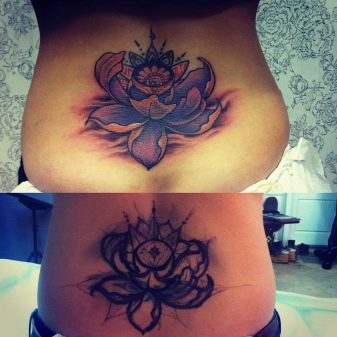

On the foot
Small tattoos are often done on the ankle, lower leg, above the knees or directly on the foot. In this case, the overlapping of the old ornament usually does not cause discomfort.
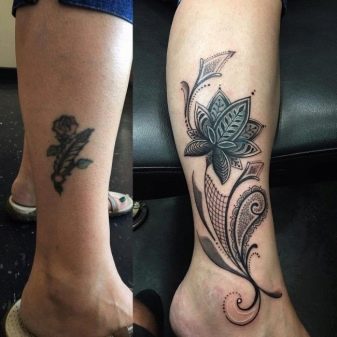
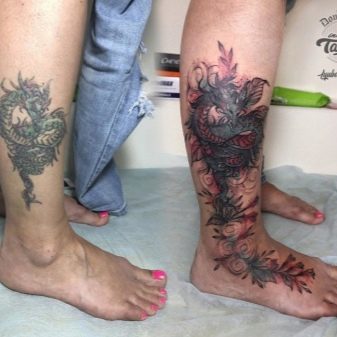
Features of the procedure
Correction of tattoos takes place in different ways. If a person wants to completely get rid of images or inscriptions on the body, lightening with a laser is used. It takes 5-10 sessions and allows you to remove both monochrome and color drawings. The more complex and voluminous the tattoo, the longer it will take to remove the pigment from the skin.

Not everyone wants to completely get rid of the ornaments on the body. Sometimes the problem lies in the low quality of the pattern, its fading. In this case, it is easier to redo the tattoo - cover it with a new pattern or pigment. Depending on the complexity of the task at hand, the master can choose the continuous application of a new ornament over the old one or its partial use. It is expensive to fix errors.
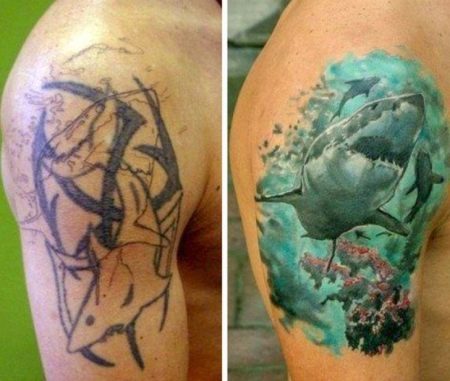
Some of the features of overlapping old tattoos include the following points.
- Selection of pigments. It is determined taking into account the possibilities for replacing some colors of the spectrum with others. For example, monochrome grays, black and white patterns are covered with colored ones. But the abundance of dark tone will greatly limit the choice of a sketch for a new tattoo. Often here you have to settle for dark purple, blue and black tones.
- Correction area. Tattoos up to 10 × 10 cm can still be corrected without completely covering them. Larger designs will need total overlap or preliminary bleaching. It is especially important to carry out lightening if the old tattoo is made in the style of old school, traditional, neo-traditional. When correcting ornaments in such techniques, the overlapping pattern will always be larger than the previous one.
- Hormonal changes. It is important for women to know that it is possible to start correcting deformed tattoos after pregnancy and childbirth only after some time. An unstable hormonal background entails a change in appearance, which means that even a new work by a master can give unsatisfactory results.
- Choice of method. There are 2 options for overlapping old tattoos - color replacement and painting, with the application of a new pattern one level higher than the old one. Each method has its own characteristics.
- Thorough follow-up care. Since the tattoo is not removed, the new pigment will always overlap the old one. Strict adherence to the skincare expert's instructions helps to maintain its brightness and clarity.

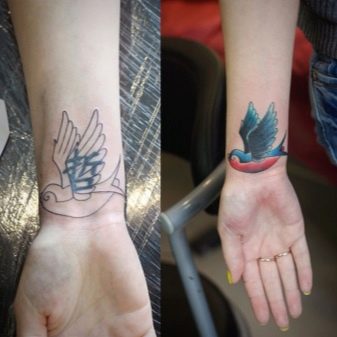
Considering all the subtleties of the process, you can make an informed decision: get rid of the old tattoo completely or try to cover it.
